Winterland Closing Blue Rose Original Poster Signed Mouse/Kelley Grateful Dead
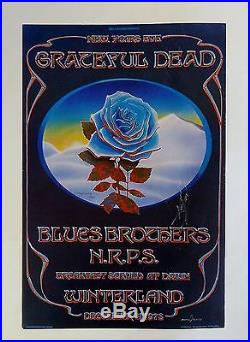
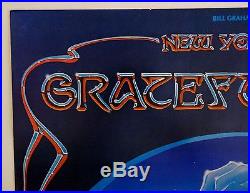
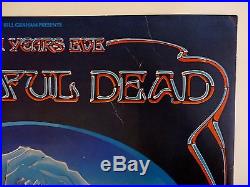
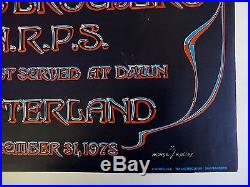

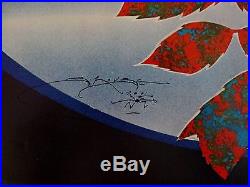
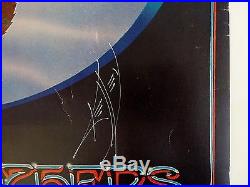


Offered is the iconic first print poster original 1st print (identified by quality paper stock and strong yellow color) used to mark the closing of Winterland. The concert was held on New Years Eve 1978 and featured the Grateful Dead whose New Year Eve concerts were legendary previously performing numerous times at the Fillmore Auditorium often until sunrise with breakfast served. Breakfast was even advertised on this poster with Breakfast served at dawn noted near the bottom.
The opening acts included the Blues Brothers with John Belushi and Dan Aykroyd shortly after their performance on Saturday Night Live as well as the New Riders of the Purple Sage. This poster is boldly signed by Alton Kelley (deceased - 2008) in silver pen with Stanley Mouses signature in pen featuring his classic Running Mouse. This poster is featured in the Art of Rock in frame 4.38. Measurements are approximately 19x 28 1/2.This poster is as mint as mint gets for a 40 year old poster. Jerry Garcia (guitar, vocals; born August 1, 1942, died August 9, 1995). Ron Pigpen McKernan (keyboards, harmonica, vocals; born September 8, 1945, died March 8, 1973).
Phil Lesh (bass, vocals; born March 15, 1940). Bob Weir (guitar, vocals; born October 16, 1947). Mickey Hart (drums, percussion; born September 11, 1943). Bill Kreutzmann (drums; born April 7, 1946). Robert Hunter (lyricist; born June 23, 1941).
Tom Constanten (keyboards; born March 19, 1944). Donna Godchaux (vocals; born August 22, 1945). Keith Godchaux (keyboards; born July 14, 1948, died July 21, 1980).Brent Mydland (keyboards, vocals; born October 21, 1952, died July 26, 1990). Vince Welnick (keyboards; born February 22, 1951, died June 2, 2006). What a long, strange trip it's been is a lyric from one of the Grateful Dead's best known songs and pretty much tells a bunch about the long history of this band. They first started to be noticed at Ken Kesey's Acid Tests where they were the house band. The Acid Test were a series of now-legendary public LSD parties (documented in Tom Wolfe's book The Electric Kool-Aid Acid Test), where Stanley Owsley manufactured the then legal LSD and plied the band and party goers with copious amounts of the drug.
By the end of'65 the band changed their name to the Grateful Dead and they were all living in a communal house situated at 710 Ashbury Street in San Francisco. They started to build a large following with their free concerts and were considered amongst the leaders of the then growing hippie movement in San Francisco. In 1966 they signed with MGM Records but the resulting recording sessions didn't go well and the label dropped the group a short time later. With 1967 came the Summer Of Love and the Dead were the top draw at the Fillmore Auditorium and other local venues.
Europe'72 would be the last album to feature Pigpen. His health had been deteriorating steady for the last couple of years from heavy drinking and sadly he passed away in 1973 of liver failure. He was replaced on keyboards by Keith Godcheaux and at the same time his wife Donna joined the band on vocals. Also in'73 was the release of their album Wake Of The Flood which was a commercial success. The Dead would end up releasing ten albums in the 70s ending with 1978's Shakedown Street which was produced by Lowell George.
At the end of 1979 the Godcheauxs were ask to leave the band as they just didn't seem to fit in to the band's plans. The following year Keith would be killed in a car crash. In 1980 their new album Go To Heaven was released with new keyboard player Brent Mydland.
In 1992 Garcia was again hospitalized with diabetes and an enlarged heart, forcing the Dead to postpone their upcoming tour. The band did come back after that to tour and Garcia looked better. But on August 9, 1995 the Dead came to an end when Garcia was found dead in bed in a drug treatment center he had just entered. His death was as much an important ending in music as was the breakup of the Beatles in 1970.With Garcia's and the Dead's passing, things in hippie land will never quite be the same again. The Grateful Dead were the most important band of the psychedelic era and among the most groundbreaking acts in rock and roll history. They broke all the rules while slowly and steadily building a career that carried them from the ballrooms of San Francisco in the Sixties to arenas and stadiums all over the country in the decades that followed. A leaderless democracy, they were fronted by guitarist Jerry Garcia, whose improvisational tangents made him a pied piper to the largest and most devoted cult following in popular music: a massive network of fans known as Deadheads.
The Dead and their followers did much to keep the spirit of the Sixties alive in modern times. The Grateful Dead and their peers on the San Francisco scene notably Jefferson Airplane, Quicksilver Messenger Service, Big Brother and the Holding Company, and Country Joe and the Fish raised the consciousness of the rock audience, leading them to an enhanced vision of music in which albums were more important than singles and concerts became marathon exercises in risk-taking.Heavily steeped in Americana, the group had its roots in blues and bluegrass. From the jazz world, the Grateful Dead leaned to approach music from an improvisational perspective.
From the culture of psychedelia specifically Ken Keseys Acid Tests, of which they were a part - the Dead became aware of the infinite possibilities for expression when imagination was given free reign. Led by Garcias guitar, the Dead would delve into blues, folk, jazz R&B and avant-garde realms for hours on end. The groups signature composition was Dark Star, which served as a foundation for their most extended and experimental jamming.
They performed this epic more than 200 times and never the same way twice, with Garcias modal guitar spearheading their explorations into uncharted territory. Theyll follow me down any dark alley, Garcia noted in 1987. Sometimes theres light at the end of the tunnel, and sometimes theres a dark hole. The point is, you dont get adventure in music unless youre willing to take chances.The Deads career can be viewed in several stages. During the latter half of the Sixties, they were a psychedelic rock band whose music and lifestyle were synonymous with the San Francisco scene.
In the Seventies, they moved toward a rootsier sound and style of songwriting while maintaining the lengthy jamming tangents that remained high points of their concerts. In the Eighties, they became a touring juggernaut, attracting a nomadic following of Deadheads that followed them from show to show. An anomalous commercial peak came in 1987 when Touch of Grey became a Top 10 hit, further accelerating the influx of younger fans to the bands increasingly prosperous touring scene. They would appear on Forbes list of top-grossing entertainers and for a few years in the early Nineties were the highest-grossing concert attraction in the U. The 1995 death of Jerry Garcia abruptly put an end to the Grateful Dead, though various members subsequently regrouped as the Other Ones, The Dead and Furthur.
The roots of the Grateful Dead hark back to the early Sixties and a small community of literature and music-minded proto-hippies in Palo Alto, California, to which Garcia gravitated. It was in this milieu that he befriended Robert Hunter, who would become his lifelong songwriting partner, and Ron McKernan a. Pigpen, a serious disciple of blues and soul who played keyboards and harmonica. A budding young guitarist named Bob Weir fell in with Garcias crew, which gathered at Dana Morgans Music Store in Palo Alto (where Garcia gave guitar lessons). In 1964 Garcia, Weir and McKernan formed Mother McCree's Uptown Jug Champions, a string band that played blues, folk and good-time music.
Much of the Grateful Deads early repertoire of borrowed tunes, including Good Morning Little School Girl and Viola Lee Blues, was learned during this time. It was Pigpens suggestion - inspired by a newly popular band from England. That they plug in and amplify their sound. They recruited a rhythm section of drummer Bill Kreutzmann (who Garcia knew from the music store, where both taught) and Phil Lesh, a musical prodigy whod studied jazz, classical and the avant-garde. Though hed never played bass before, Lesh jumped at the chance to join the band and mastered the instrument quickly. I knew something great was happening, something bigger than everybody, he recalled. By May 1965, the classic five-man lineup of Garcia, Weir, Lesh, McKernan and Kreutzmann was in place. Renaming themselves the Warlocks, they took a decidedly more electric approach. Half a year later, after realizing there was another group called the Warlocks, they became the Grateful Dead.The name suggested itself when Garcia opened up a dictionary and his eyes fell upon those words. It was a truly weird moment, he later noted. Implicit in that name was the promise of adventure and risk qualities that would become hallmarks of the Grateful Deads approach to music.
The Dead provided a kind of cultural glue, serving to link the literary and philosophical leanings of Fifties beatniks with the musical awakening of the Sixties counterculture. Both movements flourished in the enlightened environs of the Bay Area.The Grateful Dead were retained to provide musical settings for novelist Ken Keseys legendary Acid Tests. From there, they began honing their concert alchemy at San Franciscos venues, notably the Fillmore and the Avalon Ballroom. They were signed to Warner Bros. Records by Joe Smith, the companys president, after he caught a show at the Avalon in August 1966.
During their lifespan, the Grateful Dead ranged between five and seven members. In 1967, they expanded to a sextet with the addition of a second drummer, Mickey Hart. In 1968, they added keyboardist Tom Constanten, expanding to a septet.In terms of personnel, the keyboard role was always the bands most unstable. Somewhat eerily, four of the Grateful Deads keyboardists Ron Pigpen McKernan, Keith Godchaux, Brent Mydland and Vince Welnick died prematurely. The Grateful Dead fused rock and roll energy with the psychedelic experience to fashion an endlessly fascinating labyrinth of sound.
Their self-titled first album, recorded in three days, sprinted through their blues and bluegrass repertoire with speed and energy. Anthem of the Sun (1968) was their transcendently psychedelic, quasi-symphonic magnum opus. Aoxomomoxoa was another highly experimental piece of work. As good as these early albums were, they could not match the Grateful Dead when they were at their best in concert, and the group would frequently turn to live albums as the truest representation of their experience. A popular bumper sticker read: There Is Nothing Like a Grateful Dead Concert.
Live/Dead, compiled from shows performed in San Francisco between January 26 and March 2, 1969, remains a career highlight. It documented the fairly regimented yet highly improvisational program they performed at that time. The lineup included Dark Star (the ultimate Grateful Dead performance piece), St. Stephen and The Eleven (performed in 11/4 time).
After exploring the outer reaches of psychedelic consciousness, the Dead would return to earth with an energetic rendition of Bobby Blue Blands Turn On Your Lovelight (a showcase for Pigpens soulful vocals), followed by the bluesy, mournful Death Dont Have No Mercy from the repertoire of Rev. The programming mirrored the stages of an acid trip ascendancy, peaking and return to reality and its been noted that this logic became embedded in the two-set structure of the Grateful Deads concerts for the duration of their career.
As drummer Mickey Hart famously noted, Were in the transportation business we move minds. In the wake of the Sixties and the slow demise of the San Francisco scene, the Grateful Dead took a turn toward a more acoustic, back-to-basics style on Workingmans Dead and American Beauty (both from 1970). Both were more thoughtful, folk-oriented albums that revealed the band members improved songwriting ability and sage-like overview of Americas past, present and future. Much of the material was written by Garcia and lyricist Robert Hunter, and they included some of their best-loved songs: Truckin, Uncle Johns Band, Casey Jones and Sugar Magnolia.These albums were influenced by the often acoustic, harmony-laden music of. (who taught the Dead how to harmonize) and. (whose highly influential first two albums had a rustic, rootsy tone).
The Dead followed those studio albums with the consecutive live releases Grateful Dead a. Skull and Roses and Europe 72. At this point they felt so strongly that their work was best captured in concert that a number of new songs were unveiled on live rather than studio recordings.These included such staples as Grateful Deads Wharf Rat and Bertha and Europe 72s Jack Straw, Hes Gone and Tennessee Jed. Both albums also contained a raft of covers that revealed the Deads growing allegiance to roots music. There were songs by country singers Marty Robbins (El Paso), Merle Haggard (Mama Tried) and. (You Win Again), as well as the Wild West tall tale Me and My Uncle, penned by John Phillips of the. Various group members also launched solo albums during this time frame.
Jerry Garcia was first with his self-titled solo album Garcia, which appeared in January 1972. Bob Weirs Ace, released in June 1972, was a Grateful Dead album in all but name, as Weirs bandmates contributed liberally to what was the most Dead-like of all their solo projects. In 1973, the group released Wake of the Flood, their first studio album in three years and first release following the expiration of their contract with Warner Bros. It was issued on the groups own Grateful Dead Records.
They also created an affiliated label, Round Records, for solo projects. Both were distributed by United Artists. In March 1974, the group debuted a massive, state-of-the-art sound system, dubbed the Wall of Sound. It was both a sonic breakthrough and practical albatross whose setup time and cost of transport made it almost prohibitively expensive. The group released From the Mars Hotel in June, but that October exhausted from constant touring and rethinking the costly boondoggle of their sound system they went on an extended hiatus, exiting with five nights of farewell shows at San Franciscos Winterland.Among other things, Jerry Garcia spent the next two years editing The Grateful Dead Movie, a 90-minute concert documentary assembled from the Winterland stand. The group performed only four times in 1975, though they did release one of their more inspired studio albums, Blues for Allah, that year. Deadheads consider 1977 to be the bands standout year as a live band. Having folded their own labels, the Dead signed to.
Arista Records toward the end of 1976. Over the next several years, they issued the studio albums Terrapin Station (1977), Shakedown Street (1978) and Go to Heaven (1980).
Terrapin Station contained the seven-part sidelong epic Terrapin Station. Shakedown Street was notable for its choice of producer: Lowell George, guitarist and frontman for Little Feat. Following Go to Heaven, there would not be another album of new music from the Grateful Dead for seven years.
Over the latter half of their career, Garcia was periodically beset with substance-abuse problems, a state of affairs that came to a head with his arrest on drug possession charges in 1985, and his collapse into a diabetic coma in 1986. His recovery included having to relearn how to play the guitar. His health improved in the wake of those crises, and a revitalized Grateful Dead entered a period of heightened activity that included the 1987 album In the Dark and the Top 10 single ("Touch of Grey"). The group issued its final studio album, Built to Last, in 1989. Drugs continued to haunt the Grateful Dead, who lost keyboardist Brent Mydland to a fatal overdose in 1990.
Mydland was succeeded, temporarily, by Bruce Hornsby and replaced by Vince Welnick. Garcia died on August 9, 1995, at a drug-treatment facility in Forest Knolls, California.
The Grateful Deads final concert had taken place a month earlier, at Chicagos Soldier Field on July 9, 1995. The Dead could not survive the loss of Garcia, but the music lives on.Three dozen vintage concerts were released as part of the Dicks Picks series, named for Dick Latvala, the groups longtime tape archivist. Latvala, who died in 1999, was succeeded in that role by David Lemieux. Various other concerts have seen commercial release, including performances at Fillmore East, Fillmore West, across Europe and at the base of the Egyptian pyramids. Between 1991 and 2007, 53 live Grateful Dead concerts were released. Inspired by the Deads example, other artists from.
To Pearl Jam and Phish have followed suit to varying degrees, opening their own concert vaults with fan-oriented releases. Individually, the surviving members have continued to make music.Mickey Hart has pursued a highly successful career as a rhythmist and ethnomusicologist, recording and compiling numerous volumes of world music. Phil Lesh toured with a revolving cast of musicians known as Phil and Friends.
Bill Kreutzmanns other projects have included BK3 and 7 Walkers. Beginning in 1996, several Furthur Festivals involving Dead-related ensembles and kindred spirits kept the spirit alive. Weir, Lesh, Hart and Bruce Hornsby toured as the Other Ones in 1998. They were joined by Bill Kreutzmann for tours in 2000 and 2002. Calling themselves The Dead, the four surviving members Weir, Lesh, Hart and Bill Kreutzmann again regrouped with supporting musicians in 2003, 2004 and 2009.
Lesh and Weir have soldiered on with the group Furthur. Ultimately, the Grateful Deads triumph was to create an alternative form of music and alternatives to music-business conventions that succeeded on their own uncompromising terms. Much about the Grateful Dead was improvised or left to chance.
Theirs was a laissez-faire anarchy that assumed things would work out as the cosmos intended. This faith in a universal order, gleaned from the start at Keseys Acid Tests, freed them to pursue music without the usual constraints. The Grateful Dead illuminated the world with their music, transforming culture and consciousness as well.In so doing, they became an improbably durable and influential institution. As Phil Lesh said at the Grateful Deads induction into the Rock and Roll Hall of Fame in 1994: Sometimes you don't merely have to endure.
Stanley George Miller (born October 10, 1940), better known as Mouse and Stanley Mouse, is an. He was given the nickname Mouse as a ninth grader in honor of the endless rodent sketches scattered throughout his notebooks. In 1956 for mischievously repainting the facade at The Box, a popular restaurant across the street from Mackenzie. Following his junior year at nearby. Mouse completed his formal education at Detroit's Society of Arts and Crafts, but finding classes in life drawing and painting to be a bore, he instead discovered an outlet for his creative energies in the airbrush. By 1958, Mouse had become fascinated by the Taint movement that had begun in California a decade earlier.Having developed skills using an. He began painting t-shirts at. There he met and worked with. The leading exponent of Weirdo Hot Rod art. Mouse was also strongly influenced by the art of.
With whom he would later collaborate on posters and album covers. In 1959, Mouse and his family founded Mouse Studios, a. In 1964, he was invited to help in the design of. Automobile model kits using the "monster" cartoon characters he had developed to compete with Roth's. In 1965, Mouse travelled to. With a group of art school friends. With Kelley, Mouse experimented broadly with composition, lettering and imagery: Kelley came up with the ideas and Mouse executed the designs. Their work evolved into a characteristic style filled with visual puns that captured the playful, anything-goes spirit of Haight-Ashbury. Kelley, a self-taught artist, had recently arrived from. Where he had joined a group of. Who called themselves the Red Dog Saloon gang. Upon arrival in San Francisco Kelley and other veterans of the gang renamed themselves The Family Dog and began producing rock music dances. Assumed leadership of the group and began promoting the dances at the Avalon Ballroom, Mouse and Kelley began working together to produce posters for the events. Later the pair also produced posters for promoter.And for other events in the psychedelic community. Was typified by a new stylistic diversity, with his posters drawing on inspirations ranging from art deco design to British tavern signs; a poster for. Was so well received by the band members themselves that. Even invited the artist to London to "flame" his Rolls Royce. In 1967, Mouse collaborated with artists Kelley, Rick Griffin.
To create the Berkeley Bonaparte Distribution Agency. Mouse and Kelley also worked together as lead artists at Mouse Studios and The Monster Company producing. The Monster Company also developed a profitable line of. The psychedelic posters Mouse and Kelley produced were heavily influenced by. Graphics, particularly the works of.
Material associated with psychedelics, such as. Zig-Zag was one of their first posters for a concert headlined by Big Brother and the Holding Company.
'We were paranoid that the police would bust us or that Zig-Zag would bust us'' Mouse said. From 1966 to 1969 Kelley worked on more than 150 posters for concerts at the Avalon Ballroom and the Fillmore, publicizing the most famous bands and artists of the era, among them Quicksilver Messenger Service, the Butterfield Blues Band and Moby Grape, as well as the Dead, Big Brother and the Holding Company, Jimi Hendrix, and Country Joe and the Fish. They created three posters for concerts headlined by Bo Diddley, who died on Monday.
'Kelley would work on the left side of the drawing table and Mouse on the right,'' said Paul Grushkin, the author of''The Art of Rock: Posters From Presley to Punk'' and a longtime friend of both men.'They turned out a poster a week.
At the time the posters were put up on telephone poles. Everyone who attended a concert at the Avalon received a free poster advertising the next show on the way out the door. Producing posters advertising for such musical groups as. Big Brother and the Holding Company. And Grateful Dead led to meeting the musicians and making contacts that were later to prove fruitful. In 1968, Helms and Graham began turning to other artists for their poster work and Mouse's career languished. After brief periods in London and Massachusetts, he moved to. Waterbed store called The Waterbed Gallery with the walls featuring his artwork. The pair resumed their partnership in 1971 producing commercial artwork related to the Grateful Dead and later. The pair is credited with creating the skeleton and roses image that became the Grateful Dead's archetypal iconography, and Journey's wings and beetles that appeared on their album covers from 1977 to 1980. Mouse and Kelley continued to work together on rock memorabilia until 1980.In 1989, Mouse illustrated the cover of. The Grateful Dead Family Album.
A photographic music reference book written by. Although production was limited, Mouse and Kelley's 1978 Blue Rose poster, created to commemorate the closing of the Winterland Arena, is considered a classic from this decade. Mouse continued to produce album cover art and other music-related graphics through the 1980s. Early in the decade, he moved to New Mexico where he began producing fine art in a variety of media. In 1999, he contributed a portrait of.More Oar: A Tribute to the Skip Spence Album. Of songs by the co-founder of. Performed by such artists as. Stanley Mouse filled a lawsuit against the producers of the film. In 2002, alleging that the characters of Mike and Sulley were based on his drawings of Excuse My Dust which he unsuccessfully pitched to Hollywood producers in 1998.
A Disney spokeswoman responded that only the characters in Monsters, Inc. Were "developed independently by the Pixar and Walt Disney Pictures creative teams and do not infringe on anyone's copyrights". Where he continues to paint. Features Stanley's art along with other artists such as Grace Slick, Mickey Hart, Jerry Garcia, Bill and Adrianna Weber and Bob Siedemann. The gallery features the iconic rock posters of the sixties in San Francisco, creations of Mouse and Alton Kelley and also Mouses more recent works in oils. June17, 1940 June 1, 2008. Alton Kelley was born in Houlton, Me. And grew up in Connecticut where his parents moved to work in defense plants during World War II. His mother, a former schoolteacher, encouraged him to study art and for a time he attended art schools in Philadelphia and New York, but his real passion was racing motorcycles and hot rods. He applied his training to painting pinstripes on motorcycle gas tanks. Both independently and in tandem with longtime collaborator. Created some of the most distinctive and enduring images in rock music, his collages adorning countless album covers and concert posters. After working as a welder at the Sikorsky helicopter plant in Stratford, Conn. He moved to San Francisco in 1964, settling into the Haight-Ashbury neighborhood. With a group of friends he helped stage concerts in 1965 at the Red Dog Saloon in Virginia City, Nev. By the Charlatans, an electric folk-rock band. On returning to San Francisco. Co-founded the Family Dog, a collective of likeminded hipsters and activists who regularly held dances at local venues like the Avalon Ballroom and Longshoreman's Hall. He also turned to art, creating countless collages and decorating his home with bursts of Day-Glo paint and pop art designs. His work reached new heights, with. Selecting photos and assembling the collages while.'Stanley and I had no idea what we were doing,'' Kelley told The San Francisco Chronicle.'But we went ahead and looked at American Indian stuff, Chinese stuff, Art Nouveau, Art Deco, modern, Bauhaus, whatever. S collaborations succinctly captured the spontaneity and wit of both, and together they emerged among the most popular and renowned artists of the psychedelic era, their success cemented in 1968 when they were invited to exhibit their work alongside that of.In a joint show that dubbed the group the Big Five. S most memorable pieces were created for.
Inaugurated the "Skull and Roses" inspired by a 19th-century engraving from''The Rubaiyat of Omar Khayyam''. This poster advertised the concert at the Avalon Ballroom in 1966. It portrayed a skeleton wearing a garland of roses on its skull and holding a wreath of roses on its left arm.The Grateful Dead later adopted this image as its emblem. Mouse also designed several of the group's album covers, including''American Beauty'' and''Workingman's Dead. One of their first posters, for a concert headlined by Big Brother and the Holding Company, reproduced the logo for Zig-Zag cigarette papers, used widely for rolling marijuana cigarettes.'We were paranoid that the police would bust us or that Zig-Zag would bust us,'' Mouse said.
With the waning of the 1960s, Kelley and Mouse diversified. They formed Monster, a T-shirt company, in the mid-1970s.
They also designed the Pegasus-image cover for the Steve Miller album''Book of Dreams'' and several albums for Journey in the 1980s. After sharing a 1979 Grammy Award with. Published the duo's joint biography, appropriately titled Mouse and Kelley. He continued to produce posters and other printed graphics throughout the years to follow, shunning the emergence of digital technology to work by hand on a variety of pieces for the Fillmore and other Bay Area venues in addition to countless other showbiz clients. A resident of Petaluma, CA, in 1996. Also appeared in the film documentary The Life and Times of the Red Dog Saloon.'Kelley had the unique ability to translate the music being played into these amazing images that captured the spirit of who we were and what the music was all about,'' said the Grateful Dead drummer Mickey Hart.'He was a visual alchemist -- skulls and roses, skeletons in full flight, cryptic alphabets, nothing was too strange for his imagination to conjure. Alton Kelley died on June 1, 2008 at his home in Petaluma, Calif. The cause was complications of osteoporosis said his wife Marguerite Trousdale Kelley. In addition to his wife, Kelley is survived by three children, Patty Kelley of San Diego, Yossarian Kelley of Seattle and China Bacosa of Herald, Calif.
Two grandchildren; and his mother, Annie Kelley, and a sister, Kathy Verespy, both of Trumbull, Conn. I have gone through great lengths to insure that my posters have been maintained using only archival materials.
I have preserved them on acid free paper mounted by protective corners stored flat in binders. On most of the photos of posters that I will be offering you may notice these corner protectors. Should you want a cheaper alternative and are willing to accept responsibility, please contact me. Additional posters will be free of charge.Box, FPO or APO address. Box addresses in Canada are fine.
List of eligible countries are. Australia, Austria, Bahrain, Belgium, Brazil, Bulgaria, Canada, China, Croatia, Cyprus, Czech Rep, Denmark, Estonia, Finland, France, Germany, Greece, Hong Kong, Hungary, Indonesia, Ireland, Israel, Italy, Japan, Kuwait, Latvia, Lithuania, Malaysia, Malta, Mexico, Netherlands, NewZealand, Norway, Philippines, Poland, Portugal, Qatar, Romania, Russia, Saudi Arabia, Singapore, South Africa, South Korea, Spain, Sweden, Slovakia, Slovenia, Switzerland, Taiwan, Thailand, Turkey, Ukraine, United Arab Emirates, United Kingdom.
I will be offering more Fillmore Posters in the weeks and months to follow. Feel free to contact me if you have any questions or need to see additional photos of the item and I will respond to the best of my knowledge. The item(s) are from a smoke-free household. Pictures are of the actual item being auctioned. The item "Winterland Closing Blue Rose Original Poster Signed Mouse/Kelley Grateful Dead" is in sale since Friday, June 10, 2016.This item is in the category "Entertainment Memorabilia\Music Memorabilia\Rock & Pop\Artists G\Grateful Dead\Posters". The seller is "terry-dunn" and is located in Phoenix, Arizona. This item can be shipped to United States, to United Kingdom, DK, RO, SK, BG, CZ, FI, HU, LV, LT, MT, EE, to Australia, GR, PT, CY, SI, to Japan, to China, SE, KR, ID, ZA, TH, to Belgium, to France, to Hong Kong, to Ireland, to Netherlands, PL, to Spain, to Italy, to Germany, to Austria, IL, to Mexico, to New Zealand, SG, to Switzerland, NO, SA, AE, QA, BH, HR, MY, BR, PA, JM.
